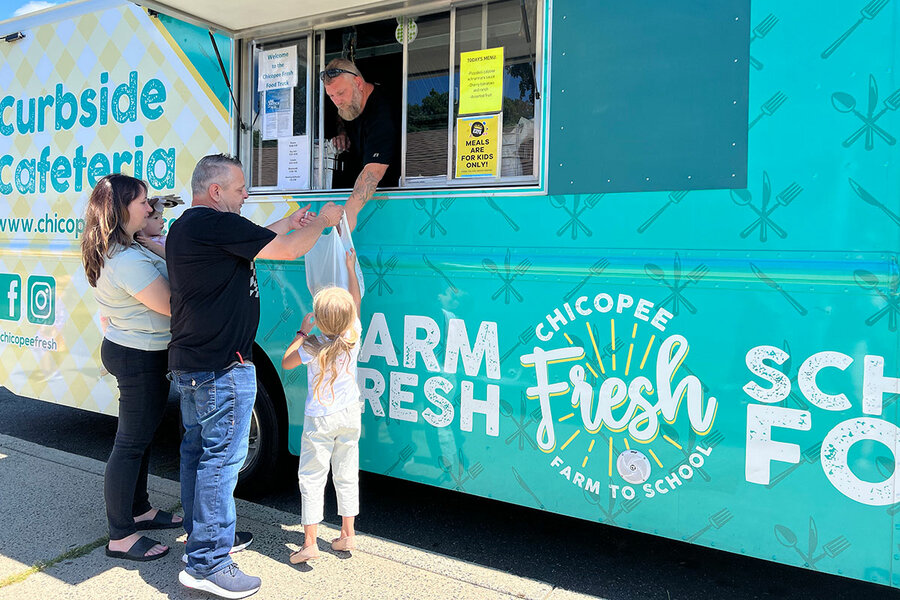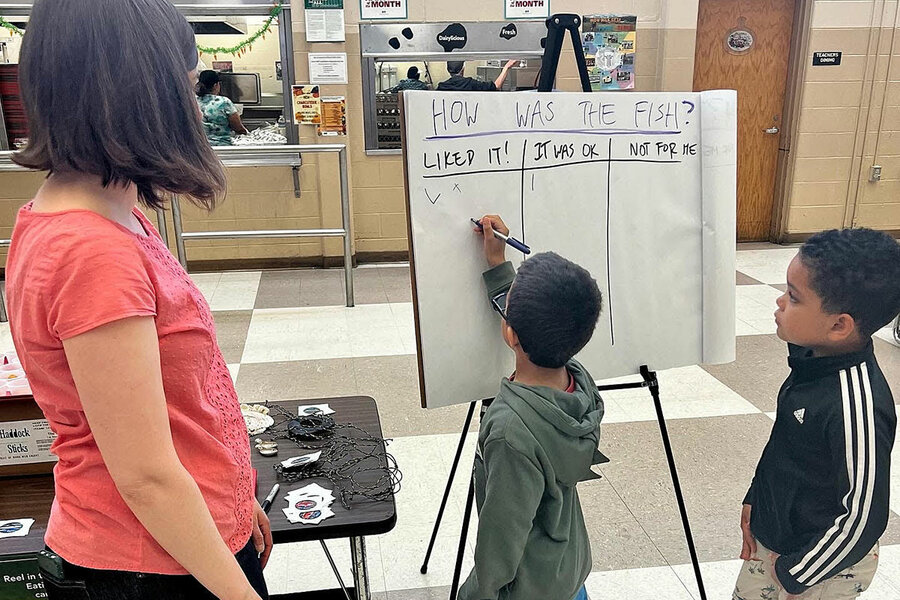With pandemic help ending, should states continue to feed all students?
Loading...
| CHICOPEE, MASS.
Advocates hope that moving forward, school meals are fresh, appealing, and available to everyone.
Their goal is to increase food quality and decrease stigma, fueling compassion for students and better learning. Proponents are counting on the higher visibility of school meals during the pandemic – with popular grab-and-go sites and federal free meals for all students for more than two years – to propel a national movement toward universal school meals.
Why We Wrote This
A story focused onFunding free meals for all students was a pandemic provision. But now that such programs are expiring, what should the next steps be to support learning and battle hunger for a wide range of students?
Inflation and supply chain issues have complicated those efforts, and critics cite concerns about an increase in food waste and the potential for paying for food for kids who don’t need the help. Even so, five states, including Massachusetts, are funding universal free school meals for the 2022-2023 academic year. Two of those states, California and Maine, passed laws making universal free school meals permanent. In most states, students will return to a system of free, reduced-price, or paid meals based on family income.
Some research shows that food insecurity affects families who don’t qualify for free meals.
“We provide textbooks to all children, we provide chairs to all kids, because those are tools that all kids need to learn,” says nutrition expert Juliana Cohen. “And nutritious food is an essential tool that all kids need as well.”
How do you make school meals more appealing? Try food trucks, smoothies, and farm-to-school recipes. Then make the food free for all students.
That strategy works in Chicopee, a small city in central Massachusetts, where the local public school district offers at least two free meals daily to nearly 7,000 enrolled public school children. During the school year fresh items from local farms appear regularly on kids’ plates. This summer the “Curbside Cafeteria,” a cheerfully painted aqua food truck, delivered meals at parks around town.
Chicopee Public Schools has offered free meals for about five years, under a federal government program that allows districts with enough students from low-income families to provide no-cost meals for everyone. Since making meals free, more kids have eaten school food, allowing the district to receive increased funds from federal reimbursement, which they reinvest into programs like the farm-to-school partnerships.
Why We Wrote This
A story focused onFunding free meals for all students was a pandemic provision. But now that such programs are expiring, what should the next steps be to support learning and battle hunger for a wide range of students?
“It’s such an innovative, fun, different [meal] program” that’s about inclusion and addressing food insecurity, says Melanie Wilk, food service director for Chicopee Public Schools. “We’re really out in the community and trying to make these connections.”
Districts like Chicopee offer a glimpse of what many advocates hope the future of school meals could be coming off the pandemic: fresh, likable, and available to everyone. The goal is to increase food quality and decrease stigma, fueling compassion for students and better learning. Inflation and supply chain issues have complicated those efforts, and critics cite concerns about an increase in food waste and the potential for paying for food for kids who don’t need it. But proponents hope the higher visibility of school meals during the pandemic – with popular grab-and-go sites and federal free meals for all students for more than two years – will propel a national movement toward universal school meals.
Five states, including Massachusetts, are funding universal free school meals for the 2022-2023 academic year. Two of those states, California and Maine, passed laws making universal free school meals permanent. Colorado residents will vote on creating a free school meals program this November. Federally, the U.S. Department of Agriculture ended its pandemic provision of universal free meals after this summer. In most states, students will return to a system of free, reduced-price, or paid meals based on family income.
Food insecurity concerns
Caring for student well-being is at the top of many supporters’ lists of reasons to provide all kids with meals. “Food insecurity is in every single ZIP code in Massachusetts and every ZIP code in the U.S.,” says Erin McAleer, CEO of Project Bread, a nonprofit hunger-fighting group in Massachusetts that’s leading a coalition advocating for state legislation to make universal school meals permanent.
“The system that we’ve had since World War II of trying to find out which kids need it and which don’t hasn’t worked. It’s been a broken system for a really long time,” says Ms. McAleer, pointing to data from her organization showing a quarter of kids who are food insecure in Massachusetts don’t qualify for free or reduced lunch meals.
Research on free school meals has shown benefits that include improved nutrition, academic learning, and attendance, as well as fewer referrals for behavioral issues or to the school nurse, says Juliana Cohen, adjunct associate professor of nutrition at Harvard University T.H. Chan School of Public Health and associate professor at Merrimack College School of Health Sciences.
“We provide textbooks to all children, we provide chairs to all kids, because those are tools that all kids need to learn. And nutritious food is an essential tool that all kids need as well,” says Dr. Cohen. “All kids, especially those from low-income households, are more likely to eat when it becomes the norm.”
Others are concerned over costs, quality, food waste, and blurred roles of families and the state if universal free school meals are expanded. Bringing meals from home might in turn become stigmatized, says Max Eden, a research fellow at the American Enterprise Institute, a Washington think tank.
“There is a substantial difference for a child or for anybody when food is provided by a loved one versus provided by a government agency,” says Mr. Eden. “If making lunches at home becomes stigmatized, if your parents do it, then that’s one less expression of love that a mother or father can provide for their child.”
Some free meal advocates thought that more than two years of universal free school meals during the pandemic could have propelled Congress toward passing federal legislation making the policy permanent, but that has not occurred.
“We really thought that we might be able to legislate universal school meals nationally and it hasn’t happened,” says Janet Poppendieck, a senior faculty fellow at the CUNY Urban Food Policy Institute and author of “Free for All: Fixing School Food in America.” “I think we are back to a community by community and state by state approach.”
The U.S. Department of Agriculture is funding school lunches and breakfasts at slightly higher reimbursement rates for the next academic year and is offering some continued pandemic waivers for extra flexibility for school districts.
“More uncertainty than ever”
Complicating efforts to expand school meals are headwinds like inflation, supply chain disruptions, and labor shortages. A July 2022 report from the School Nutrition Association says the industry faces “epic challenges” unlike anything in the 76 years since the federal government founded the National School Lunch Program.
“This year there’s more uncertainty than ever that’s being faced by operators of school meal programs,” says Lori Adkins, School Nutrition Association president and child nutrition consultant for Oakland Schools ISD in Michigan. “Since not all kids will eat for free this year, operators are uncertain about demand. We don’t know how many kids will participate in our programs this year. Demand drives everything, the amount of food you need, the labor you need.”
Ms. Adkins consults with 28 school districts in Michigan and is helping them communicate with families about filling out paperwork again to qualify for free or reduced lunches. She worries some families won’t realize they have to do this after a break of several years and kids will fall through the cracks. She’s also seeing about half the districts she works with raise prices modestly for school meals, due to inflation.
In Chicopee, the cost of gloves for food staff rose from around $14 a case to $120, says Ms. Wilk, the food service director. She switched to less well-fitting but cheaper versions and glove prices are starting to fall, she says. (The manufacturer says the price per case is now about $50.) She’s also relieved that her distributors for the fall are showing more items in-stock than they have in previous months.
Schools also have to deal with the perennial issue of food waste. A 2019 report by the World Wildlife Fund found that U.S. school food waste amounts to about 530,000 tons per year. The amount of food waste has been used as an argument against universal free school meals.
Some schools try strategies to address waste like creating a table where kids can leave unopened packaged food for other kids to take. Other helpful steps include scheduling eating time after recess and extending time for school meals, which are often limited to just 15 minutes in which students must pass through the line and consume their food, says Dr. Cohen, the nutrition expert.
“It helps financially”
On a recent summer day in Chicopee, the Curbside Cafeteria food truck maneuvers into the parking lot at Lincoln Grove park.
A “pizzaboli calzone” headlines the day’s menu, alongside cherry tomatoes and bananas. Earlier in the week locally grown peaches and pickles were featured.
Joe Fernandes; his wife, Tanya; and their two young daughters are among those picking up summer food. The family lives close by and walks to the park daily to get lunch for the kids and participate in craft activities the district offers. Mr. Fernandes’ first grader also receives school-provided lunch during the academic year, which he says is “a really nice convenience and it helps financially.”
He supports the state’s decision to continue to offer meals. “There are a lot of people who can’t afford it. It’s nice, so that every kid is equal and gets fed.”









